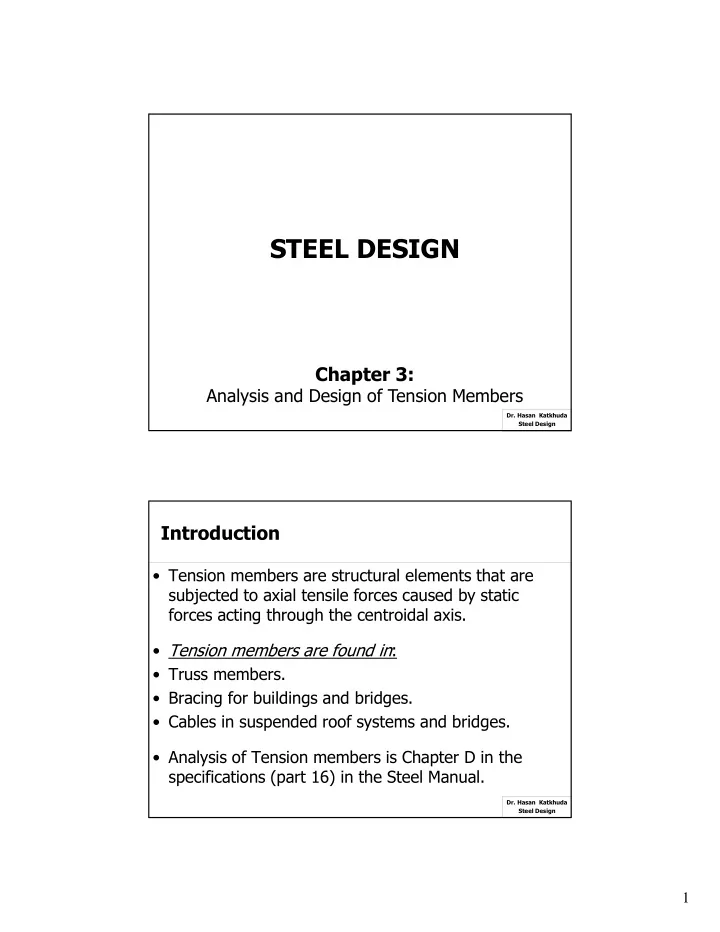

������������� ������������ Analysis and Design of Tension Members ��������������������� ������������� ������������� • Tension members are structural elements that are subjected to axial tensile forces caused by static forces acting through the centroidal axis. • Tension members are found in : • Truss members. • Bracing for buildings and bridges. • Cables in suspended roof systems and bridges. • Analysis of Tension members is Chapter D in the specifications (part 16) in the Steel Manual. ��������������������� ������������� 1
������������� • The stress in an axially loaded tension member is : f = P/A where, • P: is the magnitude of load, • A: is the cross*sectional area normal to the load. • The stress in a tension member is uniform throughout the cross*section except: • Near the point of application of load, and • At the cross*section with holes for bolts or other discontinuities, etc. ��������������������� ������������� � �����!���������� I. Rolled Steel Sections: • W, S, WT, ST, C, L II. Special Sections: • Flat bar, Rods and Cables. III. Built up Sections: ��������������������� ������������� 2
����������������� • A tension member can fail by reaching three limit states: 1. Excessive deformation initiated by yielding of the gross cross*section of the member away from the connection. 2. Fracture of the effective net area (through the holes) at the connections. 3. Block Shear fracture through the bolt holes at the connection. ��������������������� ������������� ����������������� 1. Yielding in the gross cross*section: • The nominal strength in yielding is: • Where: P n : Nominal Strength in the gross section. F y : Yield Stress. A g : Gross cross*section area Where: ��������������������� ������������� 3
����������������� 2. Fracture in the net section: • Where: P n : Nominal Strength in the net section. F u : Ultimate Stress. A e : Effective net area Where: ��������������������� ������������� ����������������� • Where: A e : Effective net area. A n : Net area for bolted connection. U : Reduction Coefficient. ��������������������� ������������� 4
����������������� • Important notes: • Note 1: Why is fracture (not yielding) the relevant limit state at the net section? • Yielding will occur first in the net section. However, the deformations induced by yielding will be localized around the net section. These localized deformations will not cause excessive deformations in the complete tension member. Hence, yielding at the net section will not be a failure limit state. ��������������������� ������������� ����������������� • Note 2: Why is the resistance factor (φ t ) smaller for fracture than for yielding? • The smaller resistance factor for fracture (φ t = 0.75 as compared to φ t = 0.90 for yielding) reflects the more serious nature and consequences of reaching the fracture limit state. • Note 3: What is the design strength of the tension member? • The design strength will be the lesser value of the strength for the two limit states (gross section yielding and net section fracture). ��������������������� ������������� 5
����"���#�"�� • Net area is the gross sectional area of the member minus the holes or notches. • The long used practice is to punch holes with a diameter 1/16 inch larger than that of the bolts diameter. • Punching damages 1/16 inch more of the surrounding metal. ��������������������� ������������� ����"���#�"�� d h = d B + 1/16 + 1/16 d h = d B + 1/8 inch (Based on the text book) • Where: • d h : diameter of the hole. • d B : diameter of the bolt. d h = d B + 1/16 inch (Based on the specifications D*3) ��������������������� ������������� 6
�$�%�����&����"���#�"�'� • Example 1: ��������������������� ������������� �$�%�����&����"���#�"�'� • Example 2: ��������������������� ������������� 7
�$�%�����&����"���#�"�'� • Example 3: ��������������������� ������������� �!!�����!����������������� • For a bolted tension member, the connecting bolts can be staggered for several reasons: 1. To get more capacity by increasing the effective net area. 2. To achieve a smaller connection length. 3. To fit the geometry of the tension connection itself. ��������������������� ������������� 8
�!!�����!����������������� • Cochrane (1922) proposed a reduced diameter to account for the effects of staggered holes: • d : is the hole diameter. • s : pitch (spacing center to center in the direction of the load) • g : transverse spacing (center to center) ��������������������� ������������� �!!�����!����������������� • w n : net width. • w g : gross width. ��������������������� ������������� 9
�$�%�����&���������������'� • Example 1: • ½ inch thick plate • d B = ¾ inch • Path ABCD : An = [11 – (2)(7/8)] (1/2) = 4.625 in 2 • Path ABCEF : An = [11 – (3)(7/8) + (3) 2 /(4)(3)](1/2) = 4.56 in 2 (controls) • Path ABEF: An = [11*(2)(7/8)+(3) 2 /(4)(6)](1/2) ��������������������� = 4.8125 in 2 ������������� �$�%�����&���������������'� • Example 2: • C 15 X 33.9, d B = ¾ inch ��������������������� ������������� 10
�$�%�����&���������������'� • Example 2: • Path ABCDEF : An = 10 – (2)(7/8)(0.65) – (2)(7/8)(0.4) + (3) 2 /(4)(9) (0.4) + (2) [(3) 2 /(4)(4.6)] ((0.65+0.4)/2) = 8.778 in 2 ��������������������� ������������� �$�%�����&���������������'� • Example 3: • L 7 x 4x 5/8 • d B = 7/8 inch • Required: • Min S that only 2 holes need be subtracted in determining net area. ��������������������� ������������� 11
�$�%�����&���������������'� • Example 3: ��������������������� ������������� �$�%�����&���������������'� • Example 3: ��������������������� ������������� 12
�!!����(��"���� • For bolted Connections: • For welded Connections: • An : Net area • Ag : Gross area ��������������������� ������������� �!!����(��"���� • Shear Lag: • Occurs when some elements of the cross section are not connected. • The connected element becomes over loaded and the unconnected part is not fully stressed, i.e. the tensile force is not uniformly distributed over the net area. ��������������������� ������������� 13
Recommend
More recommend